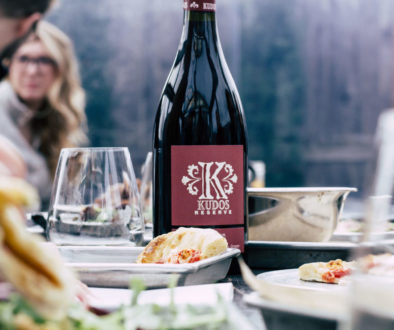You don’t need to be an expert or a supertaster to appreciate wine. We have a saying at Kudos, “if you can identify what tastes good to you and what doesn’t, you have all the knowledge necessary to enjoy wine.” With that said, here are a few helpful tips for allowing your senses to guide you along your wine journey:
See: Kudos is about taking the time to appreciate the natural beauty that is all around you, and our wine is no exception. Did you know that most wine, including reds, begin life as pale-colored grape juice? The pigment in red wine is derived from contact with its grape skins (called maceration), whereas white wine is juice from gently pressed juice grapes of varying color. The color of a wine can also give you hints about its age (i.e. both red and white wines start to brown slowly as they age), and the way it was made (i.e. red wines aged for a long time in barrel will be darker).
Smell: Ever wonder why people are always swirling the wine in their glasses (other than to look cool)? The exposure to oxygen (also called aeration) releases aroma compounds that help you smell the wine better. So, swirl away, then dive in … nose first. When wine drinkers describe varying aromas wafting from their glass, it isn’t because these ingredients were added during fermentation. In reality, wine fermentation produces chemical compounds that mimic a variety of magnificent aromas (i.e., fruits, vegetables, flowers, earth, etc.). So, wake up and smell the Pinot, people.
Taste: This is the easy part. Just as with aromas, the chemical compounds created in fermentation make for complex and dynamic flavors. These flavors fit into five categories: sweetness, sourness, saltiness, bitterness, and umami (savory). It’s also helpful to note a wine’s acidity as you swish it around in your mouth. Did you know that as an open wine is exposed to oxygen, the flavors continue to develop and change? (Of course, in our house, an open bottle rarely hangs around for very long.) Above all, always remember that the best reason to drink wine is that it tastes great.
Feel: The weight and texture of wine are part of the experience. When people describe a wine as “full-bodied,” they’re referring to a heavier, more mouth-filling wine. As for the ever popular mention of “tannins,” this refers to a chemical compound present in wine (from grape seeds, skins, and stems) that affects its astringency. Wines with more tannins cause a drying effect on your tongue and mouth, sometimes making you feel as if you’ve licked a piece of wool. It’s important to note that because white wines are usually separated from their stems, skins, and seeds prior to fermentation, they tend to have little or no tannin. So next time you taste, pay attention to how the wine feels in your mouth.
Every bottle of Kudos is a tip of the cap to the amazing place that we call home. Here’s hoping our tasting guide helps give a little Kudos to the Willamette Valley



